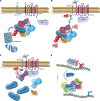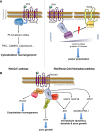Wnt and lithium: a common destiny in the therapy of nervous system pathologies?
- PMID: 23749084
- PMCID: PMC11113114
- DOI: 10.1007/s00018-013-1378-1
Wnt and lithium: a common destiny in the therapy of nervous system pathologies?
Abstract
Wnt signaling is required for neurogenesis, the fate of neural progenitors, the formation of neuronal circuits during development, neuron positioning and polarization, axon and dendrite development and finally for synaptogenesis. This signaling pathway is also implicated in the generation and differentiation of glial cells. In this review, we describe the mechanisms of action of Wnt signaling pathways and their implication in the development and correct functioning of the nervous system. We also illustrate how a dysregulated Wnt pathway could lead to psychiatric, neurodegenerative and demyelinating pathologies. Lithium, used for the treatment of bipolar disease, inhibits GSK3β, a central enzyme of the Wnt/β-catenin pathway. Thus, lithium could, to some extent, mimic Wnt pathway. We highlight the possible dialogue between lithium therapy and modulation of Wnt pathway in the treatment of the diseases of the nervous system.
Figures



Similar articles
-
The balance of TCF7L2 variants with differential activities in Wnt-signaling is regulated by lithium in a GSK3beta-independent manner.Biochem Biophys Res Commun. 2010 Aug 20;399(2):245-50. doi: 10.1016/j.bbrc.2010.07.062. Epub 2010 Jul 21. Biochem Biophys Res Commun. 2010. PMID: 20654575 Free PMC article.
-
Lithium stimulates human bone marrow derived mesenchymal stem cell proliferation through GSK-3β-dependent β-catenin/Wnt pathway activation.FEBS J. 2014 Dec;281(23):5371-89. doi: 10.1111/febs.13081. Epub 2014 Oct 27. FEBS J. 2014. PMID: 25265417
-
2,3,7,8-TCDD induces neurotoxicity and neuronal apoptosis in the rat brain cortex and PC12 cell line through the down-regulation of the Wnt/β-catenin signaling pathway.Neurotoxicology. 2013 Jul;37:63-73. doi: 10.1016/j.neuro.2013.04.005. Epub 2013 Apr 22. Neurotoxicology. 2013. PMID: 23619006
-
The Wnt signaling pathway in bipolar disorder.Neuroscientist. 2002 Oct;8(5):497-511. doi: 10.1177/107385802237176. Neuroscientist. 2002. PMID: 12374432 Review.
-
Lithium and neuropsychiatric therapeutics: neuroplasticity via glycogen synthase kinase-3beta, beta-catenin, and neurotrophin cascades.J Pharmacol Sci. 2009 May;110(1):14-28. doi: 10.1254/jphs.09r02cr. Epub 2009 May 8. J Pharmacol Sci. 2009. PMID: 19423950 Review.
Cited by
-
Pharmacological approaches to intervention in hypomyelinating and demyelinating white matter pathology.Neuropharmacology. 2016 Nov;110(Pt B):605-625. doi: 10.1016/j.neuropharm.2015.06.008. Epub 2015 Jun 24. Neuropharmacology. 2016. PMID: 26116759 Free PMC article. Review.
-
Pharmacological and toxicological effects of lithium in zebrafish.ACS Chem Neurosci. 2014 Jun 18;5(6):468-76. doi: 10.1021/cn500046h. Epub 2014 May 14. ACS Chem Neurosci. 2014. PMID: 24798681 Free PMC article. Review.
-
Potential Roles of the WNT Signaling Pathway in Amyotrophic Lateral Sclerosis.Cells. 2021 Apr 8;10(4):839. doi: 10.3390/cells10040839. Cells. 2021. PMID: 33917816 Free PMC article. Review.
-
Wnt and GSK3 Signaling Pathways in Bipolar Disorder: Clinical and Therapeutic Implications.Clin Psychopharmacol Neurosci. 2017 May 31;15(2):100-114. doi: 10.9758/cpn.2017.15.2.100. Clin Psychopharmacol Neurosci. 2017. PMID: 28449557 Free PMC article. Review.
-
New insights into Wnt signaling alterations in amyotrophic lateral sclerosis: a potential therapeutic target?Neural Regen Res. 2020 Sep;15(9):1580-1589. doi: 10.4103/1673-5374.276320. Neural Regen Res. 2020. PMID: 32209757 Free PMC article. Review.
References
-
- Ciani L, Salinas PC. WNTs in the vertebrate nervous system: from patterning to neuronal connectivity. Nat Rev Neurosci. 2005;6(5):351–362. - PubMed
-
- Carter M, Chen X, Slowinska B, Minnerath S, Glickstein S, Shi L, Campagne F, Weinstein H, Ross ME. Crooked tail (Cd) model of human folate-responsive neural tube defects is mutated in Wnt coreceptor lipoprotein receptor-related protein 6. Proc Natl Acad Sci USA. 2005;102(36):12843–12848. - PMC - PubMed
-
- Kiecker C, Niehrs C. A morphogen gradient of Wnt/beta-catenin signalling regulates anteroposterior neural patterning in xenopus. Development. 2001;128(21):4189–4201. - PubMed
Publication types
MeSH terms
Substances
LinkOut - more resources
Full Text Sources
Other Literature Sources
Medical
Miscellaneous

